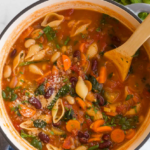Last Updated on April 9, 2025 by recipeinspire
Table of Contents
Introduction

Brief about Olive Garden’s Popular Minestrone Soup
Olive Garden, a renowned Italian-American restaurant chain, has always been synonymous with delicious and hearty meals. Among its vast menu, the Olive Garden Minestrone Soup stands out as a favorite for many. This soup, with its rich blend of vegetables, beans, and pasta, encapsulates the essence of Italian cuisine in a bowl.
- Origins: The history of Minestrone traces back to ancient Italy, but Olive Garden has given it a unique twist, making it a staple in their menu.
- Popularity: The soup’s popularity isn’t just because of its taste. Olive Garden’s marketing campaigns, such as unlimited soup, salad, and breadsticks, have further elevated its status among patrons.
- What Makes It Special: Unlike other soups, Minestrone is hearty enough to stand on its own as a main dish. Many have fallen in love with this version of the soup, especially at Olive Garden, making it a sought-after recipe for home cooks.
Furthermore, the soup’s versatility allows for various ingredients to be added or removed based on personal preferences, ensuring that each bowl is unique. Whether you’re a vegetarian looking for a filling meal or someone who loves a good, flavorful soup, Olive Garden’s Minestrone is the answer.
History and Popularity
Why it’s a Favorite for Many at Olive Garden
Olive Garden, often referred to as “The OG”, has cemented its place as the top dog of Italian-American restaurant chains. Established in 1982 in Orlando, it has grown exponentially, boasting over 900 locations in 15 countries. With a whopping $3 billion in annual sales, it’s evident that their offerings have a massive fan base. But what makes their Minestrone Soup stand out?
- Unlimited Offerings: One of the significant draws is their marketing campaign. The unlimited soup, salad, and breadsticks deal is not just a marketing gimmick but a testament to the restaurant’s commitment to providing value. This deal is especially appealing to families on a budget, ensuring they get more bang for their buck.
- Authentic Taste with a Twist: The Minestrone Soup at Olive Garden is a delightful blend of vegetables, beans, and pasta in a rich vegetable broth. It’s not just any soup; it’s a reflection of authentic Italian flavors combined with the unique touch of Olive Garden. This soup is so hearty that it can easily be the main dish, and the fact that it’s vegan is a cherry on top.
- Consistency is Key: Whether you’re dining in Orlando or any other part of the world, the taste remains consistent. This consistency ensures that patrons know exactly what they’re getting, leading to repeat visits.
Ingredients:
List of Ingredients Used in the Soup
Olive Garden’s Minestrone Soup is a delightful concoction that brings together a variety of fresh ingredients. This soup is not just a treat for the taste buds but also a nutritional powerhouse. Let’s delve into the list of ingredients that make this soup a favorite for many:
Vegetables:
The backbone of any good Minestrone Soup is its vegetables. They provide the soup with its rich texture and vibrant colors.
- Celery: Adds a slight crunch and a mild spicy flavor.
- Carrots: Gives the soup its sweetness and vibrant orange color.
- Zucchini: A soft vegetable that blends well with the other ingredients.
- Yellow Onion: Provides a depth of flavor.
- Garlic: Adds that aromatic kick.
- Green Beans: Another crunchy element.
- Baby Spinach: Wilts in the soup, providing a lovely green hue and added nutrition.
Pulses and Pasta:
These ingredients give the soup its heartiness, making it filling and satisfying.
- Cannellini Beans: Soft white beans that are a great source of protein.
- Kidney Beans: Adds a different texture and rich flavor to the soup.
- Mini Shell Pasta: These tiny pasta shells are perfect for holding onto the rich broth.
Seasonings and Broth:
The soul of the soup lies in its seasonings. They elevate the flavors of the vegetables and pulses.
- Tomato Paste: Gives the soup its rich tomatoey base.
- Vegetable Broth: The liquid in which all the ingredients simmer and meld together.
- Italian Seasoning: A blend of herbs that gives the soup its characteristic Italian flavor.
- Salt and Pepper: Essential seasonings to bring out the flavors of the ingredients.
Oils and Fats:
- Extra Virgin Olive Oil (EVOO): Used for sautéing the vegetables, it adds a subtle fruity note to the soup.
Preparation Method
Step-by-Step Guide to Making the Soup
Creating the perfect bowl of Olive Garden’s Minestrone Soup requires a blend of the right ingredients and a touch of culinary expertise. But don’t be daunted; with this step-by-step guide, you’ll be able to recreate this Italian masterpiece right in your kitchen. Let’s dive into the process:
1. Preparing the Ingredients:
Before you start cooking, it’s essential to have all your ingredients ready.
- Wash and Chop: Clean all the vegetables thoroughly. Dice the celery, carrots, zucchini, and yellow onion. Grate the garlic cloves for a more intense flavor.
- Bean Prep: Rinse the cannellini and kidney beans to remove any excess salt or preservatives.
- Pasta: Keep the mini shell pasta ready. You’ll be cooking it separately to ensure it remains al dente.
2. Sautéing the Vegetables:
The base of the soup starts with sautéing the vegetables.
- Heat a large pot or stockpot and add the extra virgin olive oil (EVOO).
- Once the oil shimmers, add the celery, onion, zucchini, carrots, and garlic. Sauté until the vegetables are slightly softened, ensuring they don’t brown.
3. Building the Soup Base:
- Stir in the tomato paste until the vegetables are well-coated.
- Pour in the vegetable broth, ensuring it covers the vegetables. This broth will be the primary liquid base for your soup.
- Add the canned tomatoes, including the juice, for a richer flavor.
4. Seasoning:
- Sprinkle the Italian seasoning, ensuring an even distribution.
- Season with salt and pepper. Remember, you can always adjust the seasoning later, so start with a conservative amount.
5. Adding the Pulses:
- Introduce the green beans and baby spinach to the pot. The spinach will wilt, and the green beans will soften as they cook.
- Stir in the rinsed cannellini and kidney beans. These beans will provide the soup with its hearty texture and protein content.
6. Cooking the Pasta:
- In a separate pot, boil the mini shell pasta in salted water until al dente, as per the instructions on the box.
- Drain the pasta and rinse with cold water to stop the cooking process. This step ensures that your pasta doesn’t turn mushy when added to the soup.
7. Final Touches:
- Once the vegetables in the soup are tender, add the cooked pasta.
- Let the soup simmer for an additional 5-10 minutes, allowing the pasta to soak up some of the flavors.
8. Serving:
- Ladle the soup into bowls, ensuring each serving has a good mix of vegetables, pulses, and pasta.
- For an authentic Olive Garden experience, serve the soup with Olive Garden’s House Salad and perhaps some Fettuccine Alfredo on the side.
9. Storing:
If you have leftovers, store the soup and pasta separately. This way, the pasta doesn’t continue to absorb the broth and become overly soft. When reheating, combine the desired amount of soup and pasta, heat, and enjoy!
Variations and Tips
Slow Cooker Version of Olive Garden’s Minestrone Soup
The allure of a slow cooker is its ability to transform raw ingredients into a culinary masterpiece with minimal effort. Olive Garden’s Minestrone Soup is no exception. Here’s how you can recreate this beloved dish using a slow cooker:
1. Ingredient Preparation:
- Ensure all your vegetables are washed, chopped, and ready to go. This includes celery, carrots, zucchini, yellow onion, and garlic.
- Rinse the cannellini and kidney beans to remove any excess salt or preservatives.
2. Building the Soup Base in the Slow Cooker:
- Start by adding the vegetable stock, diced tomatoes, celery, carrots, onion, garlic, and a mix of dried herbs (basil, oregano, rosemary, and thyme) to your slow cooker. Season with salt and pepper to taste.
- Set your slow cooker to low heat and let it work its magic for 7-8 hours. If you’re short on time, you can set it to high heat for 3.5-4 hours.
3. Adding the Remaining Ingredients:
- About 30 minutes before you’re ready to serve, stir in the zucchini, green beans, and pasta. This ensures that the pasta doesn’t get too soft and retains its al dente texture.
- After the pasta is cooked through, stir in the spinach, kidney beans, cannellini beans, and parsley. Let it cook for several more minutes until everything is heated through.
4. Serving:
- Once done, ladle the soup into bowls. For an authentic touch, sprinkle some finely shredded parmesan or romano cheese on top.
- Pair the soup with some crusty bread or Olive Garden’s House Salad for a complete meal.
5. Storing and Reheating:
If you have leftovers, it’s best to store the soup and pasta separately to prevent the pasta from becoming too soft. When you’re ready to enjoy it again, combine the soup and pasta, heat, and serve.
Tips for Best Results When Making Olive Garden’s Minestrone Soup
Achieving the perfect bowl of Minestrone Soup, reminiscent of Olive Garden’s iconic dish, requires a blend of culinary techniques and some insider tips. Here’s how you can ensure your soup is nothing short of perfection:
1. Freshness is Key:
- Always opt for fresh vegetables. The quality of your ingredients plays a significant role in the final taste of the soup. Seasonal vegetables not only taste better but also pack more nutrients.
2. Pasta Perfection:
- Cook the pasta separately and add it to the soup just before serving. This prevents the pasta from becoming too soft and mushy. As suggested by The Mediterranean Dish, this tip ensures your Minestrone soup remains authentic and delightful.
3. Layering Flavors:
- Sautéing the vegetables in olive oil before adding the broth helps in layering flavors. This technique ensures that each ingredient imparts its unique flavor, making the soup rich and hearty.
4. Slow Simmer:
- Once all the ingredients are in the pot, let the soup simmer on low heat. A slow simmer allows the flavors to meld together, resulting in a soup that’s rich and flavorful.
5. Seasoning:
- Season the soup in stages. Start with a conservative amount and adjust as the soup cooks. This ensures that the soup isn’t overly salty or bland.
6. The Final Touch:
- Just before serving, stir in some freshly squeezed lemon juice. This adds a touch of brightness to the soup and elevates its flavor.
7. Serving Suggestions:
- Serve the soup with a sprinkle of freshly grated Parmesan cheese. As noted by Cookie and Kate, this not only adds a layer of flavor but also gives the soup a creamy texture.
8. Storing Tips:
- If you plan to store the soup, keep the pasta separate to prevent it from soaking up the broth and becoming too soft. When reheating, combine the desired amount of soup and pasta, heat, and serve.
Nutritional Information
When it comes to choosing a meal, understanding its nutritional content can be crucial for many, especially those who are health-conscious or have specific dietary needs. Olive Garden’s Minestrone Soup is not only delicious but also packs a nutritional punch. Here’s a breakdown of its nutritional content:
1. Caloric Content:
- Calories: 110 kCal per serving. This makes it a relatively low-calorie option, perfect for those watching their caloric intake.
2. Macronutrients:
- Total Carbs: 17g
- Net Carbs: 13g
- Fiber: 4g
- Sugar: 4g
- Protein: 5g
- Total Fat: 1g
3. Vitamins and Minerals:
- Sodium: 810 mg. It’s essential to note this if you’re monitoring your sodium intake.
- Vitamin A: 0 mcg
- Vitamin D: 0 mcg
4. Additional Information:
While the soup is low in fats and relatively high in fiber, it’s essential to balance it with other meals throughout the day. The high fiber content can aid in digestion and provide a feeling of fullness.
For those interested in a deeper dive into the nutritional content of other Olive Garden dishes or looking for ways to modify the Minestrone Soup to fit specific dietary needs, our nutrition section offers comprehensive insights.
Moreover, platforms like Carb Manager provide detailed nutritional breakdowns for various dishes, including Olive Garden’s Minestrone Soup, which can be a valuable resource for those keen on understanding their food’s nutritional content.
FAQs
How Do You Make Olive Garden Minestrone Soup?
Recreating the iconic Olive Garden Minestrone Soup at home is a delightful culinary experience. This soup, loaded with vegetables, beans, and pasta in a rich tomato broth, is a favorite for many. Here’s a step-by-step guide to making this delicious soup:
1. Ingredient Preparation:
- Gather all your ingredients: onion, celery, carrots, zucchini, garlic, tomatoes, vegetable broth, tomato paste, Italian seasoning, white beans, kidney beans, green beans, small shell pasta, baby spinach leaves, and parsley.
2. Sautéing the Vegetables:
- In a large pot, heat olive oil over medium-high heat. Add the onion, celery, carrots, and zucchini. Cook until the vegetables are tender, which usually takes about 3-5 minutes. Add garlic and cook for an additional 30 seconds. Season with salt and pepper.
3. Building the Soup Base:
- Add the tomatoes, vegetable broth, tomato paste, and Italian seasoning to the pot. Bring the mixture to a simmer.
4. Adding Beans and Pasta:
- Introduce the white beans, kidney beans, green beans, and pasta to the pot. Let it simmer for about 10-15 minutes or until the pasta and vegetables are tender.
5. Final Touches:
- Adjust the seasoning with salt and pepper as needed. Stir in the spinach leaves and let them cook until they wilt, which should take about 2-3 minutes. Finish off by sprinkling parsley over the soup.
What Vegetables Go Into Minestrone Soup?
Minestrone soup is celebrated for its rich medley of vegetables, making it not only a flavorful delight but also a nutritious option. The choice of vegetables can vary based on personal preferences, regional variations, and seasonal availability. However, the classic Olive Garden Minestrone Soup incorporates a specific set of vegetables:
1. Base Vegetables:
- Onion: Provides a foundational flavor.
- Celery: Adds a slight crunch and aromatic essence.
- Carrots: Imparts a sweet undertone.
2. Additional Vegetables:
- Zucchini: Offers a soft texture and mild flavor.
- Tomatoes: Gives the soup its characteristic tangy base.
- Green Beans: Introduces a fresh bite.
- Spinach: Adds a touch of earthiness and vibrant green color.
3. Optional Additions:
While the above vegetables are staples in the Olive Garden version, many variations of minestrone soup might include:
- Russet Potatoes: For a heartier texture.
- Butternut Squash: For a sweet and creamy element.
- Kale: A nutrient-dense alternative to spinach.
- Leeks: For a milder onion flavor.
How Can You Modify the Recipe Based on Available Ingredients?
One of the beauties of Minestrone Soup is its adaptability. While there’s a classic recipe that many adore, the soup can easily be modified based on the ingredients you have on hand. Here are some suggestions to tailor the recipe to your pantry:
1. Vegetables:
- No Zucchini? Use yellow squash or even bell peppers.
- Missing Green Beans? Snap peas or broccoli can be a great substitute.
- Instead of Spinach: Try kale, chard, or any other leafy green.
2. Beans and Pulses:
- No Cannellini Beans? Great Northern beans, chickpeas, or even lentils can work.
- Kidney Beans: If these aren’t available, pinto beans or black beans can be used.
3. Pasta:
- Different Pasta Shapes: While mini shell pasta is classic, you can use elbow macaroni, ditalini, or even broken spaghetti.
4. Broth:
- Vegetable Broth: If you don’t have this, chicken or beef broth can be used. For a vegetarian option, even water with a bouillon cube can suffice.
5. Seasonings:
- No Italian Seasoning? A mix of dried basil, oregano, rosemary, and thyme can be used. Fresh herbs can also elevate the flavor.
6. Additions and Toppings:
- Cheese: Parmesan is classic, but Romano or Asiago can also be sprinkled on top.
- Meat Lovers: While traditional Minestrone is vegetarian, adding ground turkey, chicken, or even sausage can make it heartier.
Can the Soup Be Frozen for Later Use?
Absolutely! Freezing Minestrone Soup is a practical way to enjoy this delightful dish over time, ensuring you have a ready-to-go meal on hand. Here’s how to properly freeze the soup to retain its flavor and texture:
1. Cool It Down:
- Before freezing, it’s crucial to let the soup cool to room temperature. Placing hot soup directly in the freezer can affect the temperature of other frozen items. To expedite the cooling process, you can place the soup pot in an ice-water bath in your sink and stir frequently.
2. Portion It Out:
- Divide the soup into individual servings using quart-size freezer bags or freezer-safe containers. This not only ensures easy portion control but also allows the soup to freeze uniformly.
3. Separate Grains and Pasta:
- Pasta and grains in the soup can absorb liquid and become soft when frozen. To maintain their texture, consider freezing them separately and combining them when reheating the soup.
4. Hold the Dairy:
- Dairy components, like cream or cheese, can separate and become grainy when frozen. It’s best to add these ingredients when reheating the soup.
5. Keep Vegetables al Dente:
- To ensure vegetables retain their texture when reheated, cook them until they’re just tender. This way, they won’t become overly soft after freezing and reheating.
6. Labeling:
- Clearly label the soup containers with the recipe name, date, and any reheating instructions. This ensures you know what’s inside and how to best prepare it later.
7. Reheating:
- When you’re ready to enjoy the soup, thaw it in the refrigerator overnight. Then, reheat on the stove, adding any reserved ingredients like pasta, grains, or dairy.
Conclusion
Summarizing the Love for Olive Garden Minestrone Soup and Encouraging Readers to Try It
The allure of Olive Garden Minestrone Soup is undeniable. This hearty, vegetable-packed soup has captured the hearts of many, becoming a staple in the culinary world. But what makes it so special?
1. A Symphony of Flavors:
- The soup boasts a harmonious blend of fresh vegetables, beans, and pasta, all swimming in a rich tomato broth. Each spoonful promises a burst of flavors, making it a favorite for both the young and old.
2. Nutritional Powerhouse:
- Beyond its taste, the soup is a nutritional gem. Packed with fiber from beans and vitamins from vegetables, it’s a wholesome meal that nourishes the body. For those keen on understanding the nutritional benefits, our nutrition section delves deeper.
3. Versatility:
- The adaptability of this soup is another reason for its widespread love. Whether you’re a vegetarian, vegan, or meat-lover, the soup can be tailored to fit your dietary preferences.
4. A Culinary Journey:
- Every bite of the Minestrone Soup transports you to the rustic Italian countryside, offering an authentic taste of Italy’s rich culinary heritage.
In conclusion, the Olive Garden Minestrone Soup is more than just a dish; it’s an experience. It embodies warmth, comfort, and the joy of sharing a meal with loved ones. If you haven’t yet indulged in this delightful soup, now’s the time. Dive into our recipe section and embark on a culinary adventure that promises to tantalize your taste buds.
Encourage the joy of exploration! Take a moment to discover the incredible posts shared by others:
- runed scarlet ruby recipe
- Kardashian Salad Recipe
- The Ultimate Guide to the Mexican Candy Shot
- Halloween Punch Recipes: A Spooky Delight for All Ages

Olive Garden Minestrone Soup: A Deep Dive into Its Rich Flavors and History
- Total Time: 45
Description
Olive Garden’s Minestrone Soup is a beloved classic, known for its hearty blend of vegetables, beans, and pasta in a flavorful tomato broth. This recipe captures the essence of the restaurant’s version, offering a rich and satisfying soup that’s both nutritious and comforting. Perfect for a chilly day or when you’re in the mood for a wholesome meal, this soup is sure to become a favorite in your household.
Ingredients
- 2 tablespoons olive oil
- 3/4 cup onion, diced
- 1/2 cup celery, sliced
- 1/2 cup carrots, peeled, quartered and sliced
- 1 zucchini, quartered and sliced
- 2 teaspoons minced garlic
- Salt and pepper to taste
- 1 can (14 ounces) diced tomatoes
- 4 cups vegetable broth
- 1/4 cup tomato paste
- 2 teaspoons Italian seasoning
- 1 can (15 ounces) small white beans, drained and rinsed
- 1 can (15 ounces) kidney beans, drained and rinsed
- 1/2 cup frozen cut green beans
- 1/2 cup small shell pasta
- 2 cups baby spinach leaves
- 2 tablespoons chopped parsley
Instructions
- Heat the olive oil in a large pot over medium-high heat. Add the onion, celery, carrots, and zucchini. Cook until the vegetables are tender (about 3-5 minutes).
- Add the garlic and cook for an additional 30 seconds. Season with salt and pepper.
- Incorporate the tomatoes, vegetable broth, tomato paste, and Italian seasoning. Bring the mixture to a simmer.
- Add the white beans, kidney beans, green beans, and pasta. Let it simmer for 10-15 minutes or until the pasta and vegetables are tender.
- Adjust the seasoning with salt and pepper. Stir in the spinach leaves and let them wilt for 2-3 minutes.
- Garnish with chopped parsley before serving.
Notes
This recipe serves 4-6 people.
- Prep Time: 15
- Cook Time: 30
Keywords: Olive Garden Minestrone Soup









9 thoughts on “Olive Garden Minestrone Soup: A Deep Dive into Its Rich Flavors and History”
Comments are closed.